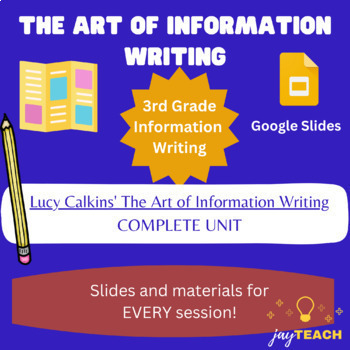The Art of Information Writing Complete Unit
- Google Drive™ folder

Description
Slides and materials for each session! Are you teaching students nonfiction, informational, or expository writing? This ART OF INFORMATION WRITING COMPLETE UNIT product pairs seamlessly with Lucy Calkins' 3rd Grade Information Writing Unit 2: The Art of Information Writing and requires no prep for teachers teaching the Units of Study by Lucy Calkins.
It includes 21 ready-to-go mini-lessons including teaching points, turn & talks, modeling, active engagement, independent practice, and shares (via Google Slides) AND corresponding graphic organizers/materials (checklists, charts, writing organizers, etc.) that make the writing process more streamlined and systematic (PDF).
To purchase each individual bend:
If Powerpoint is more your thing:
Click here for the COMPLETE UNIT Powerpoint version
This product includes:
- 21 ready-to-use Google Slides mini-lessons (Session #1: Teaching Others as a Way to Prime the Pump; Session #2: The Power of Organizing and Reorganizing; Session #3: New Structures Lead to New Thinking; Session #4: Laying the Bricks of Information; Session #5: Organization Matters in Texts Large and Small; Session #6: Studying Mentor Texts in a Search for Elaboration Strategies; Session #7: Making Connections within and Across Chapters; Session #8: Balancing Facts & Ideas from the Start; Session #9: Researching Facts and Ensuring Text Accuracy; Session #10: Reusing & Recycling in the Revision Process; Session #11: Creating Introductions through Researching Mentor Authors; Session #12: Taking Stock and Setting Goals; Session #13: Putting Oneself in Readers' Shoes to Clear Up Confusion; Session #14: Using Text Features Makes it Easier for Readers to Learn; Session #15: Fact Checking Through Rapid Research; Session #16: Punctuating with Paragraphs; Session #17: Plan Content-Area Writing, Drawing on Knowledge from across the Unit); Session #18: Revising from Self-Assessments; Session #19: Crafting Speeches, Articles, or Brochures Using Information Writing Skills; Session #20: Bringing All You Know to Every Project; Session #21: A Final Celebration)
- 13 ready-to-use graphic organizers for informational text including a TABLE OF CONTENTS, BOXES & BULLETS, 5 EXPERT FACTS, HAND, PROS/CONS, and WEB that correspond with the lessons (PDF)
Can be used for:
- Students engaging in informational writing
- Students writing nonfiction books
- Students engaging in "The Art of Information" unit by Lucy Calkins
- Students engaging in Writing Workshop
Let's Connect:
Website: jayteach.com
Instagram: JayTeach IG
Blog: 3 Time-Saving Ways to Teach the Units of Study By Lucy Calkins
You Also Might Like:
Bringing History to Life Complete Unit


